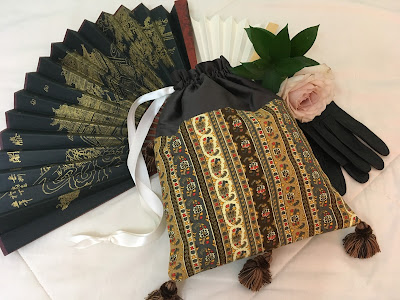"'Whom are you going to dance with?' asked Mr. Knightley.
She hesitated a moment and then replied, 'With you, if you will ask me.'
'Will you?' said he, offering his hand."
~ Jane Austen, Emma
At long last, the 1830s sky blue ball gown is complete! I began the project back in December (see the Project Planning post), but after several frustrations, set the pieces aside. That was until this past week, which was February Break for college, when I realized that it would make the perfect entry for this month's Historical Sew Monthly Challenge: Re-Make, Re-Use, Re-Fashion!
Worn over a proper shift, the new corset and sleeve puffs, flounced bum roll and three petticoats, the silhouette came together. Vintage gloves, matching costume pearl bracelets, ribbons and a belt with a gold buckle accessorized the look. And by far, the hairdo, with its towering plumes, flowers, ringlets and bow (all cleverly hiding my current copper ombré style), was my favorite part!
The next step was to find a suitable location for the photo shoot. For sure, I was envisioning a grand (passably-period-looking) staircase and the George Eastman Mansion was so kind to allow us to photograph inside! In fact, the response could not have been more welcoming! Several lovely people spoke with us, asking about the dress, and there were a lot of group pictures. The two ladies that we conversed with in the interactive sitting room (pictured above) were among the most memorable. I highly recommend a visit to the George Eastman Museum if you haven't already!
Finally, I am so grateful to Maria, my sister and photographer, for all of her time and talent! Without her, none of these photo shoots would be possible, and it is her artistic eye - despite the busy Saturday crowd, the rainy and overcast day - that brings my historical dress-up dreams to life. A million thanks, Maria! *All photographs courtesy of Maria M.*
Completed Project Shots
I could have danced all night
I could have danced all night
And still have begged for more
I could have spread my wings
And done a thousand things
I've never done before
I'll never know
What made it so exciting
Why all at once
My heart took flight
I only know when he
Began to dance with me
I could have danced, danced, danced,
All night!
Even though it was raining outside, we decided to take a couple of shots in our favorite location as a just because...and I'm so pleased that we did since the sky blue sari fabric photographed spectacularly!
Historical Sew Monthly Entry Details
The Challenge: February: Re-Make, Re-Use, Re-Fashion - Sew something that pays homage to the historical idea of re-using, re-making and re-fashioning. Turn one thing into another. Re-fit or re-fashion an old gown into something you would wear again. Re-trim a hat for a new outfit, or re-shape a modern hat to be a historical hat. Re-purpose the fabric from an old garment (your own or a commercial one) into a new garment.
My sky blue 1830s ball gown falls under the "re-purpose" category as the fashion fabric was originally a satin sari. And, as a bonus, the lace frill was "re-used" from a 1970s prom dress!
Material: One sky blue and gold satin sari, cotton twill for lining, cotton organdy for sleeve lining, interfacing for interlining, white satin for piping, blue cotton for hem facing
Pattern: Drafted my own. The sleeves were re-cut several times.
Year: Early-1830s
Notions: Cotton cord for piping, re-purposed lace, metal hooks and eyes, ribbon and metal pin backs, thread and twill tape
How historically accurate is it? Material-wise, not very...the burn test (unfortunately) confirmed that the sari is most likely poly, and the lace is only accurate for 1970...however, the overall cut, design and construction methods would be recognizable for the early-1830s. So, 25%?
Hours to complete: Did not keep track, but too many! This dress was very intense on the hand, and every seam needed to be overcast. (Polyester ugh!)
First worn: For pictures!
Total cost: Well, the sari was a generous gift from one of my Aunt's "de-stashing," and most everything else had been bought for other projects or pulled from the stash...so I'd guess a very reasonable $25-$30?











































